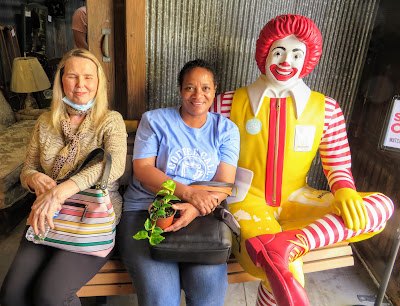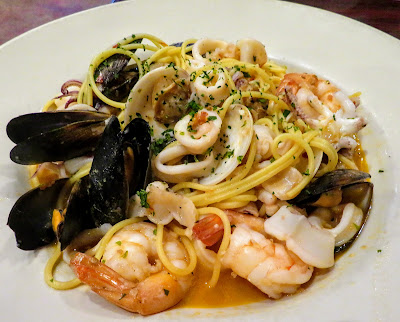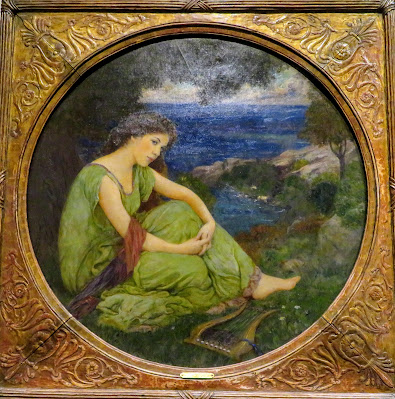Laurel
Mississippi is not a big city. The
estimated current population is somewhere in the vicinity of 18,500 although
Jones County has a population close to 70,000 residents. In any case, cities or counties of this size
are rarely homes to significant art museums.
Laurel is an exception to this rule!
The
Lauren Rogers Museum of Art is located on Fifth Avenue, surrounded by early 20th
Century homes, and only a block from the center of town. The museum opened in 1923. It is a memorial to Lauren Eastman Rogers,
the only grandson of two of Laurel’s founding families. Lauren died from complications of
appendicitis at the age of 23.
His
father, Wallace Brown Rogers and his maternal grandfather, Lauren Chase Eastman,
created the Eastman Memorial Foundation.
Its intent was to “promote the public welfare by founding, endowing and
maintaining a public library, museum, art gallery and educational institution. The museum and library was erected in 1923,
on the foundations of Lauren Roger’s house, which had not been completed at the
time of his death.
This
beautiful Georgian Revival structure, now almost 100 years old, has been
enlarged over the years. The original
building not only served as art museum, but it also served as Laurel’s town
library. A new wing, with 5 new display
galleries, was added in 1924. Another
addition was completed in 1983.
This
beautiful lobby was originally part of the library. With its quarter-sawn golden oak paneling and
cork floors, it is a stunning space.
Craftsmen created detailed naturalistic motifs, including
constellations, the earth, moon and sun in plaster on the ceiling. Hand wrought iron gates, railings and
hardware throughout the original building were created by a master blacksmith
in Pennsylvania.
No longer
the town’s general library, the Lauren Rogers Museum of Art Library is now a
reference library containing more than 10,000 books specializing in art history
and art reference with special emphasis on the Museum’s collections. Library materials may only be used in the
library.
I took
this photo of Laurie, her sister Bonnie and Bonnie’s husband Bill, as they
perused some of the materials on display in Museum’s Reading Room. The original art gallery was housed in this
room which is adjacent to the main lobby.
The room is filled with family memorabilia and portraits as well as
furnishings from the home of Lauren’s mother, Nina Eastman Rogers.
When we
entered the library we were greeted by volunteers and docents, one of which met
with us in the Reading Room. She did a
nice job of providing us with the background and history of the founding family
and of the museum. FYI, the museum is
free but of course, donations are welcome.
Following
our orientation, we began our tour of the various galleries. I took a representative group of photos as we
went along.
The
painting at the top of the photo is entitled “Autumn in New Hampshire”.
This oil on canvas painting was completed in 1857 by Albert Bierstadt
(1830 – 1902) He began painting scenes in New England and upstate New York and
he was part of a group of artists known as the Hudson River School. Bierstadt is best known for his painting of
the western United States.
The lower
painting is named “Harvest Moon” and
it was painted by Ralph Albert Blakelock. (1847 – 1919. The date of the painting is unknown. Blakelock was a romanticist American painter
known for his landscape paintings related to the ‘Tonalism’ movement. Basically, tonalism refers to the painting of
landscape forms with an overall tone of colored atmosphere or mist.
The
museum also owns works by Winslow Homer, George Inness, John Kensett, John H.
Twachtman and John Singer Sargent. It is
one of the finest collections of 19th and 20th century
paintings that can be found in the southern United States.
This
painting is entitled “A Glimpse of Long
Island Sound from Montauk” and it was finished in 1907. The artist was Thomas Moran. (1837 – 1926)
Like Bierstadt, Moran was a member of the Hudson River School who moved on to
become even more famous for his paintings of the American west.
The
circular shape of this painting is called a ‘tondo’ and it was invented by
ancient Greek artists. This oil on
canvas painting is titled “Voice of the
Sea”. It was finished in 1908 by
Stephen A. Douglas Volk. (1856 - 1935) Volk was an American portrait and figure
painter as well as a muralist and educator.
He taught at the Art Students League of New York and he was one of the
founders of the Minneapolis School of Fine Arts.
This is “Portrait of Nicholas Brewer II”, ca.
1800. It was painted by James Peale
(1749 – 1831), brother of prolific portraitist Charles Wilson Peale. Charles famously painted several portraits of
George Washington. Although James is
better known for his miniatures and his still life paintings, he too painted
portraits, at least one of which was also of Washington.
This work
is entitled “The Mystery of a Southern
Night”. It was painted in 1941 by
William Hollingsworth. (1910 – 1944) Hollingsworth was from Jackson Mississippi
but he studied art at the Chicago Art Institute.
When Hollingsworth returned to the south, he
became particularly interested in the African American residents of the city
who were kept separate from the white society.
Hollingsworth produced a plethora of paintings in his short life. He committed suicide when he was only
34. His better works can be purchased
from various auction houses for between $4,000 and $8,000, but “The Mystery of a Southern Night” is
considered one of his very finest.
This
painting of a cadet is entitled “Portrait
of Harmon Smith”. It was completed
in 1937 by Howard Chandler Christy (1873 – 1952) Christy was an American artist
and illustrator. He created the “Christy
Girl”, a colorful successor to the “Gibson Girl”. Christy is also known for his World War I
military recruiting and Liberty loan posters.
His 1940 masterpiece, entitled “Scene
at the Signing of the Constitution of the United States” is on display
along the east stairwell of the US Capitol.
To view
this patriotic painting at the Capitol you can go to: https://en.wikipedia.org/wiki/Scene_at_the_Signing_of_the_Constitution_of_the_United_States#/media/File:Scene_at_the_Signing_of_the_Constitution_of_the_United_States.jpg.
This oil
paints on Masonite painting by Reginald Marsh (1898 – 1954) is titled “East River” and it was completed in
1952. Early in his career, Marsh was a
newspaper illustrator. An American
painter, Marsh was born in Paris but he is most noted for his depictions of
life in New York City during the 1920’s and 1930s. His murals that were created in 1937 line the
arched ceiling of the Alexander Hamilton US Custom House.
In
addition, two of his murals that were created as part of the Treasury
Department’s Section of Fine Arts Depression era programs, are on display at
the William Jefferson Clinton Federal Building.
This one is entitled “Sorting the Mail”
and since I have a ‘thing’ for depression era murals, I ‘had to’ include it.
Back to
the exhibits at the Lauren Rogers Museum of Art in Laurel Mississippi… Around
1900, Catherine Gardiner read an article about Native American baskets and with
the encouragement of her husband, she started building her collection. Catherine was Lauren Rogers’s great-aunt and
in 1923 she donated almost 500 rare North American Indian baskets and related
artifacts to the new museum. Currently
the museum’s collection includes 796 objects… This is a small sampling of the
items on display. There are a number of impossibly tiny baskets on display as well.
I believe
that this colorful woven bag is called a corn husk bag…although it’s so
colorful, it would seem counterintuitive to burden it with a load of corn. Laurie and I love Native American baskets and
weavings of all types. For the most
part, older items like this are both utilitarian and artistically pleasing…amazing
creations.
This
unusually shaped basket is a ‘Jump Dance Basket”. The Jump Dance is conducted every 2 years by
Native Americans from the Hoopa Tribe from Northern California. This dance is one of a 3-part ceremony that
is designed to bring balance back into the world.
With each stitch of the basket the weaver
breathes life into its creation and makes way for the basket to take its place
as a living part of the community. As an
active participant in the ceremony, the basket is responsible for the critical
task of removing evil from the world and for putting good back into it…
The
museum’s art collection includes 5 different segments or groups. The smallest of these groupings is its 65
piece collection of European paintings, engravings and sketches on paper. The European collection dates from the 17th
Century and into the 20th Century.
Twenty-four of these works were donated by the Eastman and Rogers
families during the museum’s early years.
This
painting from 1907 by Dutch artist Bernard de Hoog (1866 – 1943) is titled “Woman and Baby”. The artist specialized in small paintings
focused on life of country people in the Netherlands. His success was made easier by him being
granted a subsidy from the Dutch Queen.
He also worked for some time under one of the greatest Dutch animal
painters, Jan van Essen.
I never
did learn the title or name of the artist of that large portrait behind this
spectacular display of silver. Harriet
Stark Gibbons was a former museum trustee and her husband owned the local
newspaper, the “Laurel Leader-Call”.
They had spent years collecting silver objects and in 1972 and1973, they
donated their extensive collection to the Lauren Rogers Museum.
The photo above shows just a portion of the Gibbons Silver Collection which includes 65
major Georgian Silver pieces including tea caddies, tea and coffee pots, baskets
for cakes and sweetmeats, and salvers.
FYI…The
term “Georgian” simply refers to the period between 1714 and 1830 when four
King Georges in a row ruled England.
In the
1920s, W.B. Rogers, Lauren Rogers’ father, donated 142 eighteenth and
nineteenth century Japanese woodblock prints.
This
3-panel work is entitled “Returning from
an Outing in the Hakone District”.
It was created in 1788 by Katsukawa Shuncho. Shuncho was active from the 1770s through the
1790s. These prints are referred to as
ukiyo-e…which means “images of the floating world”. It is a reference to the theater and
entertainment districts of urban Japan, especially those in Kyoto and Edo…that
latter now known as Tokyo.
While the
3 panel print shown above is very nice, I prefer the depictions of outdoor
scenes. This print is titled “Windy Day at Yokkaichi”. It is one of 53 themed panels created by
Utagawa Hiroshige (1797 – 1858). The
entire set, which is entitled “The 53
Post Stations of the Tokaido” was completed over a four year period, from
1831 to 1834.
This
painting is aptly named “The Ferry”. This oil paint on canvas work was completed
ca. 1850 by French painter Constant Troyon (1810 – 1865) He actually began his
career as a painter of porcelain and that skill served as his income base as he
refined his artistic talents.
Troyon’s
earlier works are considered to be of little note but from 1850 until 1864 his
abilities and recognition blossomed.
Paintings featuring animals are among his best works. He seemed to love cows... “Cattle Drinking” which is owned by the
Walters Art Museum in Baltimore Maryland is special. Troyon’s works are also featured in major art
museums in Glasgow and London as well as at the Louvre in France and in the
Metropolitan Museum of Art in New York City. A pair of his paintings of dogs recently sold
for over $136,000…
This
realistic and detailed painting was completed very recently, in 2018. Entitled “Homeless”, this oil on linen work was
completed by Bo Bartlett (1955 - ). His
goal was to evoke the feeling of someone looking for a place where you can
belong, feel welcome and safe.
Bartlett
is an American realist painter and film maker.
In addition to the Lauren Rogers Museum of Art, his works are owned by
at least 10 other major museums in the USA, including the spectacular Crystal
Bridges Museum in Bentonville Arkansas.
Sculptures
are fairly difficult to photo graph, especially if they are made from dark
materials. This was the best of the
group on display, at least ‘photographically’ in the museum.
“Mother and
Child”, a bronze sculpture on a mahogany base was created in 1972 by Elizabeth
Catlett (1915 – 2012) Catlett was an American and Mexican sculptor and graphic
artist best known for her depictions of the Black-American experience in the 20th
century.
She was the grandchild of
former enslaved people. While earning
her Master of Fine Arts Degree at the University of Iowa, renowned artist Grant
Wood, a professor at the university at the time, encouraged her to present
images drawn from Black culture and experience.
She moved to Mexico and took citizenship there after being made the
subject of an investigation by the McCarthy Committee. She continued her work until she was into her
90s.

I thought
that I’d end this cross sample of the art works on display at the Lauren Rogers
Museum of Art with this work by Charly Palmer (1960 - ). Entitled “Leadbelly”, it was completed in
2012. It is a tribute piece to Huddle
William Ledbetter (1888 – 1949). Known
as Lead Belly, Ledbetter was a famous American folk and blues musician. His music covered everything from gospel to
women, liquor, prison life, racism, cowboys, sailors and famous people…such as
Franklin D. Roosevelt, Adolf Hitler, Jean Harlow and Howard Hughes. He was posthumously inducted into the Rock
and Roll Hall of Fame in 1988.
“Leadbelly”
is part of a series of works utilizing a stained-glass theme. To quote, “The thought of fragmented, or
perhaps fractured, images goes beyond simply the people, but the idea of
controlled information.” Palmer attended
the School of the Art Institute of Chicago and received a degree from the
American Academy of Art. He created the
1996 Olympic Poster and the US Olympic Committee also selected him to paint the
US Olympic Poster for the Winter Olympics in Nagano, Japan.
Just
click on any of the photos to enlarge them…
Thanks
for taking a tour of the Lauren Rogers Art Museum and Library with us. To learn more about the library and museum,
go to LRMA – Lauren Rogers Museum of Art | Laurel, MS.
Take
Care, Big Daddy Dave
































































